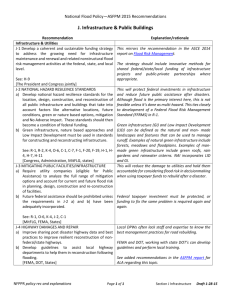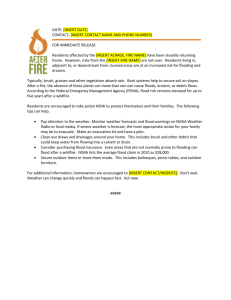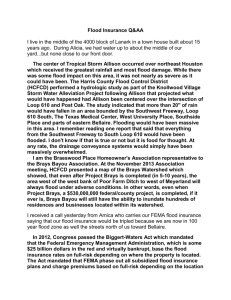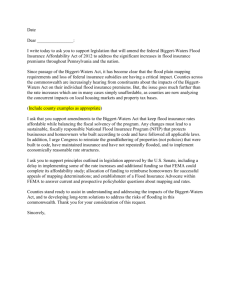more information - Braeswood Place Homeowners Association
advertisement
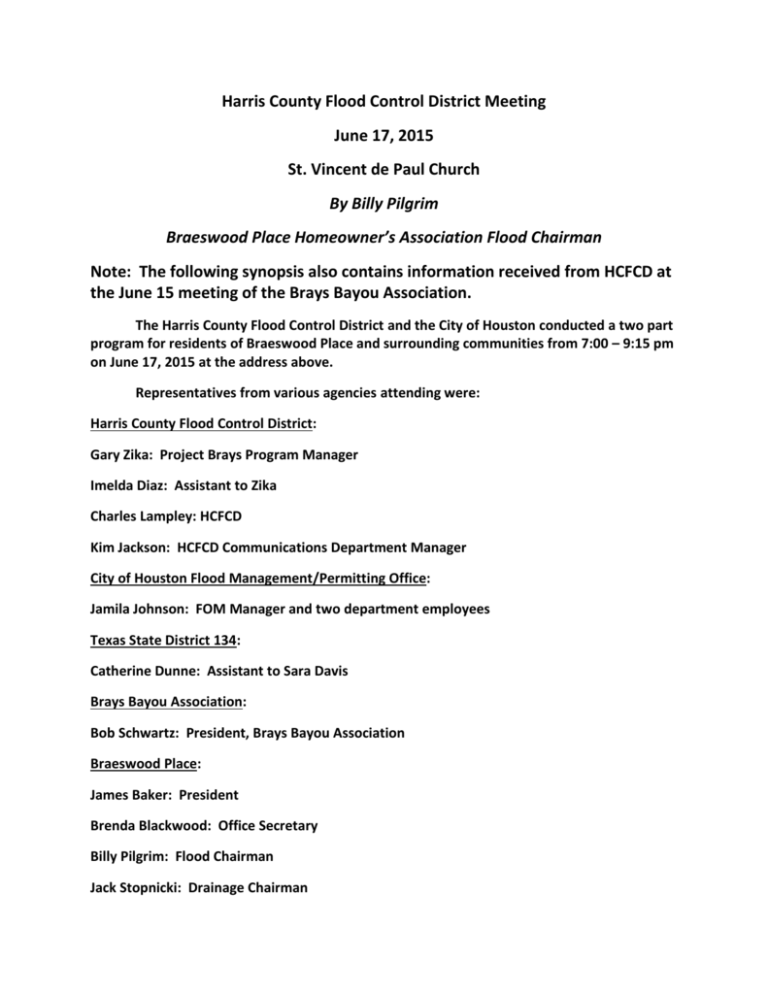
Harris County Flood Control District Meeting June 17, 2015 St. Vincent de Paul Church By Billy Pilgrim Braeswood Place Homeowner’s Association Flood Chairman Note: The following synopsis also contains information received from HCFCD at the June 15 meeting of the Brays Bayou Association. The Harris County Flood Control District and the City of Houston conducted a two part program for residents of Braeswood Place and surrounding communities from 7:00 – 9:15 pm on June 17, 2015 at the address above. Representatives from various agencies attending were: Harris County Flood Control District: Gary Zika: Project Brays Program Manager Imelda Diaz: Assistant to Zika Charles Lampley: HCFCD Kim Jackson: HCFCD Communications Department Manager City of Houston Flood Management/Permitting Office: Jamila Johnson: FOM Manager and two department employees Texas State District 134: Catherine Dunne: Assistant to Sara Davis Brays Bayou Association: Bob Schwartz: President, Brays Bayou Association Braeswood Place: James Baker: President Brenda Blackwood: Office Secretary Billy Pilgrim: Flood Chairman Jack Stopnicki: Drainage Chairman Council Member Ellen Cohen: Valerie Luna Council Member Larry Green: None There was a fairly large audience at last evenings meeting, probably between 75-100 people. First on the agenda was an abbreviated presentation of HCFCD’s Project Brays which was presented by Gary Zika, Project Brays Program Manager. A brief explanation of the intent of Project Brays and how the completion of phases of the project so far served to reduce the flooding during the Memorial Day event. Project Brays is a $430M co-shared project between HCFCD and the Corps of Engineers with $289M spent to date. HCFCD performs the planning, engineering and oversees construction. As segments/phases of the project are completed, HCFCD invoices the Corps which, after Congress approves the funds, reimburses HCFCD for 50% of the cost. HCFCD then uses the reimbursement funds to further additional phases of the project. The intent of Project Brays is to reduce the risk of, BUT NOT ELIMINATE, flooding in the Brays Bayou floodplain. When originally conceived, the project was supposed to be complete in 2014. Due to lack of funding following the 2008 recession, which was calculated as needing to be $20M per year, was greatly reduced. However, during the time frame since 2008, HCFCD has submitted enough invoices for completed segments to be able to continue the project as funds are received. NOTE: President Obama included $0 in the 2016 Federal Budget for Project Brays. Also, at the August BBA meeting, Steve Fitzgerald, HCFCD Chief Engineer, will report on his recent annual trip to D.C. to meet with our congressional delegation and the Corps of Engineers. Preliminarily, it appears that he will have some good news about Project Brays. Project Brays is a federal flood risk reduction project, one of only two in Texas, that includes widening 21 miles of the Brays channel from the Houston Ship Channel to Fondren and replacement/raising of 32 bridges. It also includes four storm water detention facilities in the upstream part of the watershed in western and southwestern Harris County. They are the Arthur Storey Park, Old Westheimer, Eldridge Road and Willow Waterhole Greenway. To date, 20,230,986 cubic yards of earth has been excavated. Once Project Brays is complete, HCFCD will submit a “Letter of Map Revision” to FEMA requesting that FEMA resurvey the Brays floodplain. HCFCD has already submitted such a request with regard to the four detention basins which FEMA has accepted. It must now go through the evaluation process leading to granting the request. Upon completion of Project Brays, e.g., all channel widening, bridge replacement, etc., HCFCD will submit another request for a “Letter of Map Revision” to FEMA which is quite a complicated pprocess. At some point in time, FEMA will resurvey the Brays floodplain and issue new Flood Insurance Rate Maps (FIRMS) which should remove an estimated 30,000 structures from the 100-year floodplain and reduce flood insurance rates. When completed the four detention basins will detent 67B gallons of water which would normally flow downstream during adverse events such as the Memorial Day flood. During the Memorial Day event, the four basins worked as designed and detented some 6700 acre feet of storm water, which, had they not existed, would have added to the storm water coming downstream making flooding even more extensive than it was. The Memorial Day flood was caused by almost 11 inches of rain in 3 hours in southwest Harris County. Project Brays is designed on the federal 100-year standard of being able to sustain 13.2 inches of rainfall in 24 hours. Note that it is a 24 hour period. There is no drainage facility that can withstand 11 inches of rain in 3 hours. So the Memorial Day event exceeded by huge amounts what the bayou can handle. When complete, Brays will handle 30% more storm water that it does today. But again, it will not eliminate flooding. Currently HCFCD is planning a phase of the project from Bertner Street in the Texas Medical Center to 2,200 feet upstream of Buffalo Speedway at the outfall on the south bank between Timberside and Bevlyn streets. This segment will be about 2 miles in length. Construction is scheduled to begin and complete in 2016 and will require excavation of 300,000 cubic yards of dirt requiring 20,000+ truck trips to dispose of the excavated materail (a typical dump truck holds 7 cubic yards). There will be a traffic management program and street closures will be minimized. Trees lost during the project will be replaced with new ones although not on a one-for-one and size-for-size basis. In some cases, where real estate is available, groves will be planted. The Brays Bayou Hike & Bike Trail will remain open except in areas under construction and will be replaced at bank top when construction is complete. To date, HCFCD has planted 36,846 trees in segments of the completed project. Following this phase, another segment from the outfall on the south bank of the channel to South Rice west of IH610 will be done in 2017. Those two segments will complete the channel widening through this area of southwest Houston. In 2018/19, the last segment from South Rice to Fondren will be done. That will complete the channel widening. However, of the 32 bridges scheduled for replacement, only 10 have been replaced to date. Replacement of the remaining bridges will not be undertaken until the channel widening has been completed and the control structures have been installed in the channel at the four detention basis listed above. During the second part of his presentation, Zika related how the completed work served to reduce the risk of flooding downstream. The four detention basins performed as designed. They will perform to maximum design when the control structures are completed this year. At this time, preliminary data shows that 7,000 cars/trucks were lost to flood waters. There were 2,600 structures flooded. There were 7 fatalities. Boots on the ground surveys following the flood revealed that vegetation growth in the various channels is low and did not impede flow with the 1st mowing of the year by HCFCD currently underway. There was no tidal influence on the water flowing to Galveston Bay/Houston Ship Channel during the Memorial Day storm. There was almost no flooding of homes (2 known) downstream where the channel widening is complete. Meyerland had 800 homes flooded, 500 for the first time. Many of them also flooded during the 1975 flood and many did not have flood insurance. Westbury had 400 homes flooded and Willow Meadows had 105. According to John Ninehauser, 15% of the homes in Linkwood sustained flood damage. Braeswood Place had 222. Zika showed a number of slides and aerial views of locations such as the detention basins and the amount of storm water they held back. All in all, Zika’s presentation was very professional and well received by the audience. His presentation was followed by a question/answer session. The second part of the program was presented by Jamila Johnson, Manager of the COH Flood Management/Permitting Office. She presented a slide program with regard to the role of FOM in the management and permitting procedures required to obtain building permits to repair the flood caused damage to pre-damage condition. The COH Flood Management Office is mandated to follow Federal Emergency Management Administration rules and regulations. She explained the various procedures, methods and remedies by which residents can navigate the system. She also said that her office is increasing staffing in order to serve the public by increasing hours and opening on Saturdays. FOM representatives manned a table where the audience could obtain brochures about the FOM procedures. The meeting adjourned at 9:15 pm.




